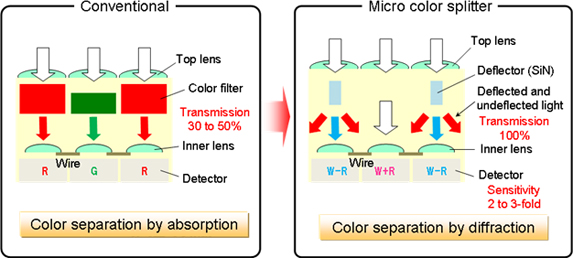Panasonic Publishes Paper on New Camera Sensor
Television camera design currently falls in to two types. There is the classic three-sensor design with a dichroic block splitting the light into red, green and blue. The other is the single-chip camera, with a color filter array, with each photosite presented with red, green or blue light filtered by dyes in the array.
The February 2013 issue of Nature Photonics publishes a paper from Panasonic “Efficient colour splitters for high-pixel-density image sensors”.
It describes a hybrid, with beam splitting at the photo-site level. Using micro color splitters or near-field deflection, the beam impinging on a single photosite is split into Y-R and R (presumably on alternate rows it would be Y-B and B). The red beam is combined with Y, resulting the row of sensors producing alternating Y+R, Y-R. The alternating row creates Y+B. Y-B. Matricing would derive R, G and B.

This configuration achieves the full resolution of the sensor for the Y signal, as opposed to the interpolated Y signal of a typical Bayer CFA.
The associated press release claims “vivid color photographs can be taken at half the light levels needed by conventional sensors”. “Vivid” is not a term I recall from my days of lining up cameras, but I guess consumers may understand it.
It is certainly an interesting design that may one day be seen in professional cameras. It all depends on colorimetry and chips yields. The low-pass, band-pass, and high-pass filters of the dichroic block need further correction to achieve the required spectral response for a television camera. Bayer filter can use precisely tailored dyes to achieve the desired results. The Panasonic design would need to achieve the same spectral response as existing cameras to be accepted as a sensor for professional use. Otherwise it will find application with consumers looking for vivid colors. Over time we will see were this new imaging technology takes us.
I plan to download the paper and have a more detailed read of what could be an interesting development for television cameras.
The professional video industry's #1 source for news, trends and product and tech information. Sign up below.
